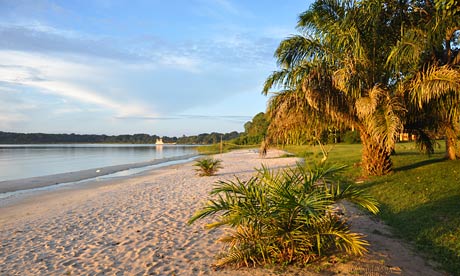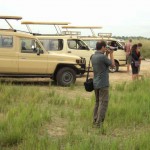
Ssese Island’s History
The Ssese Island came into existence about 12000 years ago when a tectonic shift caused an elevated basin situated between two main arms of the great rift valley to flood, forming Lake Victoria as we know it today. Little is known about the earliest inhabitants of Ssese, but some oral traditions associated with the creation of Buganda claim that its founder Kintu hailed from the islands of the Gods. In pre-colonial times it was customary for the kings of Buganda to visit the Islands and pay tribute to the several balubaale whose main shrines to Mukasa, spirit of the lake, on Bubembe. Some Buganda historical sources romanticize this relationship, claiming that in pre-colonial times Ssese due to its exalted status was never attacked by Buganda, nor was it formally incorporated into the mainland kingdom. In reality, while Ssese probably did enjoy a degree of autonomy, it was clearly a vassal of Buganda for at least a century prior to the colonial era. Further more while the Baganda revered the Islands’ spirits, Stanley recorded that they looked down on their human inhabitants for their “coal-black colour, timidity, superstition, and generally uncleanly life”
The most popular legend associated with a deity from Ssese islands dates from mid 16th century war, when Buganda, led by Nakibinge, was being overwhelmed in a war against Bunyoro. Nakibinge visited the Islands in search of support, and was offered the assistance of the local king’s youngest son, Kibuuka, who leaped to the mainland in one mighty bound to join the war against Bunyoro. Tall and powerful though, Kibuuka-which means the flier-was also possessed of a somewhat more singular fighting skill. A deity in human form, he was able to fly high above the clouds and shower down spear on the enemy, who had no idea from where the deadly missiles emanated. Led by Kibuuka’s aerial attacks, rout followed rout, and the tide of war reversed swiftly in Nakibinge’s favour as the Baganda army proceeded deeper into Banyoro territory.
Although Buganda went on to win the war, Kibuuka did not survive to enjoy the spoils of the victory. After yet another successful battle, the Baganda soldiers captured several Banyoro maidens and gave one to kibuuka as his mistress. Kibuuka told the Munyoro girl his secret, only to find that she had vanished overnight. The next day, Kibuuka sailed up into the sky as normal, and was greeted by a barrage of Bunyoro spears and arrows projected up towards the clouds. Kibuuka fell wounded into a tall tree, where he was spoted the next.
LOCATION
Situated in the northwest of Lake Victoria, the Ssese Islands form one of Uganda’s prime destinations for casual rambling and off-the-beaten-track exploration, as well as for game fishing, in particular Nile perch. For much of the 1990s, the islands were entrenched as perhaps the most popular backpacker’chill-out destination in Uganda. Although their attractions have not diminished in recent years, their popularity evidently has, attributable perhaps to the suspension of ferries from Port Bell as well as the burgeoning tourist development at the more accessible Lake Bunyonyi in Kigezi.
The Ssese Archipelago consists of 84 separate Islands, some large and densely inhabited, others small and deserted, but lushly forested thanks to an annual average rainfall in excess of 20,000mm. Only two islands regularly receive tourists. The more established of these is Buggala, the largest, most accessible and most developed Island, which is privately owned and the site of a popular budget resort. Other Islands that can be visited with varying degrees of ease are Bubeke, Bukasa and Bufumira.
Not least amongst Ssese Islands’ attractions are their rustic character and the sense of being well away from established tourist circuit. But as in other out-of –the-way places, it is suggested that you dress conservatively except in resort and campsite ground and to swim with a T-shirt on.
PLACES TO STAY
BUGGALA ISLAND
Extending over 200km2 and measuring 43km from East to west, Buggala is the largest Island set within the Uganda waters of Lake Victoria and the best developed for tourism, linked to the mainland by a regular motor ferry and dotted with accommodation to suit most tastes and budgets. Kalangala, the administrative centre for the Islands, is an unremarkable small town situated on a ridge at the eastern end of Buggala, while the nearby Lutoboka Bay hosts the Island’s main cluster of beach resorts. Another important landmark on Buggala is Luku, the small village on the western extreme of the Island where the motor ferry from mainland docks. A good dirt road connects Luku to Kalangala, and several minor roads run to other villages lying further south on the Island.
The most common large mammal on Buggala is the Vervet monkey, often seen in the vicinity of Lutoboka and Kalangala. Bushbucks and Black- and –white colobus are present but seldom observed. Over the 12000 years that the Island has been separate from the mainland, one endemic creek rat and three endemic butterfly species have evolved. Water and Forest birds are prolific. Expect to see a variety of hornbills, barbets, turacos, robin-chats, flycatchers and weavers from the roads around Kalangala. Particularly common are the Jewel-like pygmy kingfisher, the brown-throated wattle-eye and a stunning morph of the paradise flycatcher intermediate to the orange and white phases illustrated in most East African field guides. African fish eagles and Palm nut vultures are often seen near the lake, while immense breeding colonies of little egret and great cormorant occur on Lutuboka and other bays.
Although many visitors to Buggala stick to the beach resort at Lutuboka, the island also offers some great possibilities for unstructured walking. Strike out in any directions from Kalangala and you will be greeted with pleasing views over the forested and grassy clearings to the Lake Shore and more distant islands.
A popular cycling excursion is to Mutumbula swimming beach-reputedly free of bilharzias-off the road towards Luku. Travelers tend to concentrate along Kalangala-Luku road, and justifiably so, since the road heading south from Kalangala is far more cultivated. One potentially interesting goal in this direction is the marshy southwestern shores which harbour small numbers of hippo as well as a population of sitatunga antelope with larger horns that the mainland equivalent, regarded by some authorities to represent an endemic Island race. Without a private vehicle, you would probably need to do an overnight walking or cycling trip to get to these swamps.
SSESE PALM BEACH;
this one has an attractive location near the water and a variety of accommodation options to suit most budgets. This resort also offers it’s own executive tents with beds. It has two types of bandas available some repaired together and others detached.
BUKASA ISLAND;
Overlooking on of the biggest bays on the Island, this is a very friendly place to stay as father Christopher loves to chat. The only cheap place on this Island is Father Christopher’s guest house. Accommodation is in small rooms. Facilities are quite basic, but hot water can be arranged with notice. Like wise if you want to eat here, it is best to book this in advance as they will need to pick up supplies.
SCORPION LODGE;
this one is located in Liku above the Bukakata Ferry Docks. It does large local meals and bikes are available for hire, but few travelers choose to hang around Liku.
PTA ANDRONIC LODGE;
this is another cheap option in Kalangala. Camping is very possible and beds are fit for budget travelers. You can also access cheap meals as well as drinks. The owner of this place is a real traditional devotee. He is an eccentric and you may be forced to believe he has met the pope. He writes PTA On each and every house an indication that he might be worried about thieve however when you ask him why, then he give you very complicated elucidations.
GETTING THERE AND AWAY
A ferry connects the Islands from Bukakata, while small wooden boats run from Kasenyi. This take around 35 minutes from Kampala.
There is also an asymmetrical air service to the Islands run by MAF
(Mission Aviation Fellowship). It has a small sea plane and charges USh 35000 one way.
A reliable bus service connects Kampala to Kalangala leaving the new taxi park in Kampala at 0900 hours daily except for Sunday it leaves at 1100hrs.It is also possible to travel between Masaka and Kalangala in hops something that might take only 2hours. The easiest leg of the trip is getting to Nyendo junction which lies 2 km from Masaka along a stretch of the old Kampala road covered by inexpensive taxis. Next step worth timing to tie in with the ferry departure times given above is getting to Nyendo to Kabassese Jetty, an hour’s trip that is preferably undertaken in the confort of a shared taxi rather than on the back of a dangerously overcrowded pick up truck. You will then have to chill down at kabassese with a cold soda. Once at Luku, regular shared pick-up trucks to Kalangala charge around sh2, 000 per person, while special hire costs around sh20, 000. Public transport stops at Andronica and a walk to Lutoboka bay takes 20minutes. Take the sign posted path to your left after following the main road through a small town to the police station.

 Posted in
Posted in 

